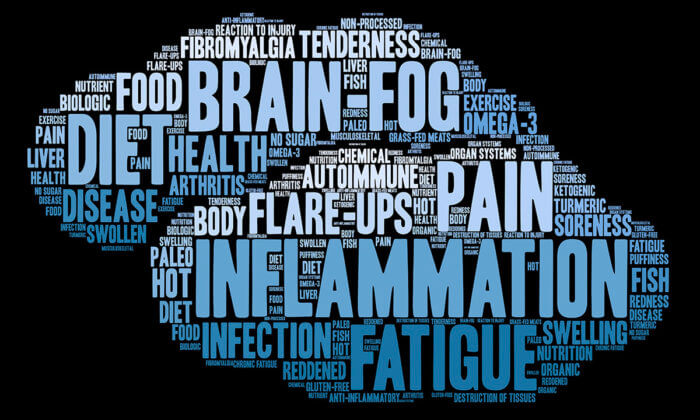How To Reach The 100-Year Life With NAD+ (Part II – Regulate CD38)
To live a long healthy life, it’s important to boost NAD+ levels with supplements, but you also have to regulate CD38, the enzyme that depletes NAD+.
| | Reading Time: 10 minutes

The “Age Wave” futurist Ken Dychtwald predicted is upon us.[1] It’s no secret. Baby boomers are getting older. But what do we call aging boomers? Older adults? That’s too generic. Not outdated terms like Gray Panthers or Senior Citizens popular in my mother’s “the greatest generation” era. To make it more taxing, boomers reject labels like “aging” or “old.” And, they prefer longevity, prolonging health, and life extension to anti-aging.
Public health and medical achievements of the 20th century gave many an additional thirty years of life. Fewer are dying young and more are living longer. In 1900, less than 0.4 percent of people in the U.S. lived beyond 80 years. In 2000, that increased to 9.2 percent. By 2020 the prediction is upward of 12.8 percent.[2]
Kathy Casey-Kirshling, born one minute after midnight on 1946, was first baby boomer to turn 65 in 2011, the year that marked the first wave of 79 million American boomers to qualify for Medicare. By 2030, one billion boomers worldwide will be over 65. If this longevity trend continues, by 2050, over 30 percent will be over 80; that’s already the percentage of seniors in many cities in Florida. Joseph Coughlin, the author of The Longevity Revolution, and founder of M.I.T.’s AGELAB believes they will become be the largest consumer market in history.

But, are boomers healthier than previous generations? Will they live longer? How many will make it to 100?
Though people are living longer, it doesn’t mean they’re healthier. A 2019 paper in the British Medical Journal[3] found that despite the popular notion that baby boomers are healthier than past generations, there was no difference in the number of chronic conditions they have.
Boomers like to defy reality. They perceive themselves in better health than there often are, and believe they’ll remain youthful holding off the degenerative changes and infirmity of old age. They’ll try just about anything that promises physical improvement and mental renewal. And, boomers spend a lot of money on health and wellness. That’s why supplements like NAD+ boosters hit the market big in the last few years.
From my clinical perspective, I feel trapped between two generations. One is facing their twilight years while the other acts as if it’s mid-afternoon. True, many of my patients are productive, active, and healthy in their 80s. They want to enjoy leisure time, play golf, attend plays and film festivals, take a luxury cruise, or travel to safe but culturally enriching destinations like Machu Picchu. In terms of their healthy, they choose conventional medicine first and come to natural medicine when it’s too late.
On the other hand, my boomer patients desire healthy, robust aging as long as possible. They take more risks. They spend more money on themselves, take supplements, and understand the importance of prevention. They have an affinity for the exotic like expensive superfoods, eating at ethnic restaurants, and trendy treatments like stem cell therapies. But are their expectations of a long healthy life realistic? If so, what’s the best way to achieve a 100-year life?
Common Sense Longevity Secrets
Right from the start, I remind them: the secret to living a long time, is not to die young. And, there’s no shortcut to disease prevention. You can’t enjoy your last decades if you’re sick. Most boomers get it. They will have more years than previous generations. Many will make it into their 90s; some will reach 100 years. But at what expense? What anti-aging therapies work, and which ones are more hopeful than useful?
Is a realistic goal for those extra thirty years youthful wellness? By that, I mean maintaining blood chemistry profiles of a 35-year-old. And, the preservation of clear thinking, better energy, good eyesight and hearing. In my clinical experience, this is an achievable goal for most people. However, it’s essential to prevent age-related chronic illnesses like coronary artery disease, and the tissue atrophy of osteoporosis and sarcopenia. Don’t be blindsided by denying these biological realities.
I believe with a healthy plant-based diet, maintaining normal weight, avoiding metabolic syndrome, getting regular exercise, plus routine physical exams and comprehensive blood workups, you can achieve healthy aging up to 85. Some will remain healthy and active into their early-90s. But the next goal is harder. Can we extend life further to reach a 100-year life? Does NAD+ play a pivotal role in achieving that goal?
In Part I of How To Reach The 100-Year Life With NAD+, I introduced NAD+ (nicotinamide adenine dinucleotide) as an ancient coenzyme necessary for health and longevity. In this blog, I discuss how to inhibit the enzyme that lowers NAD+ levels.
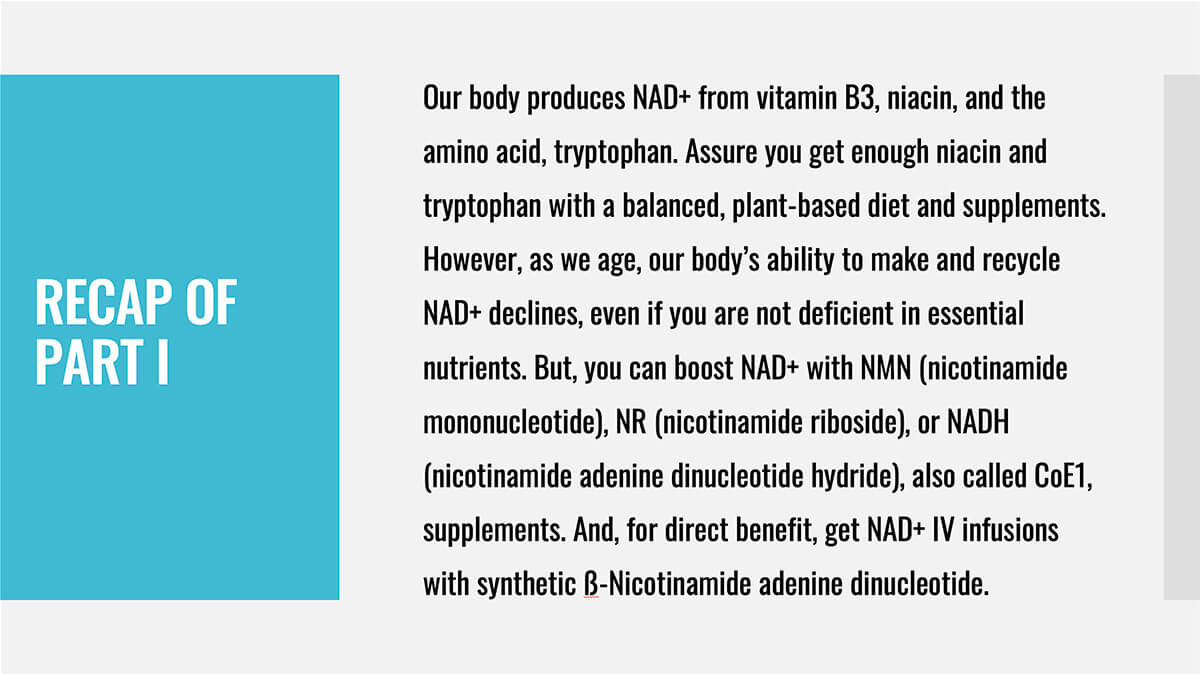
What’s Is NADase CD38?
NAD+ nucleosidase (NADase) is an enzyme, a protein that regulates NAD+. When it combines with water in the cell, it breaks down NAD+ into nicotinamide, adenine diphosphoribose, and hydrogen. CD38 (cluster of differentiation 38) is the major NADase that degrades NAD+ and modulates cellular NAD+ homeostasis.[4] Scientists believe CD38 dictates NAD+ decline during aging[5] and may trigger multiple myeloma and other cancers.[6]
Chronic Inflammation Accelerates the Rate of Aging
Not only does CD38 reduce NAD+ levels, but too much CD38 can cause chronic inflammation, and a viscous circle occurs because too much inflammation triggers more CD38. Researchers at the Mayo Clinic College of Medicine’s Kogod Aging Center found that aging cells secrete inflammatory substances termed “senescence-associated secretory phenotype” substances (SASP factors) causing a condition called “inflammaging.”
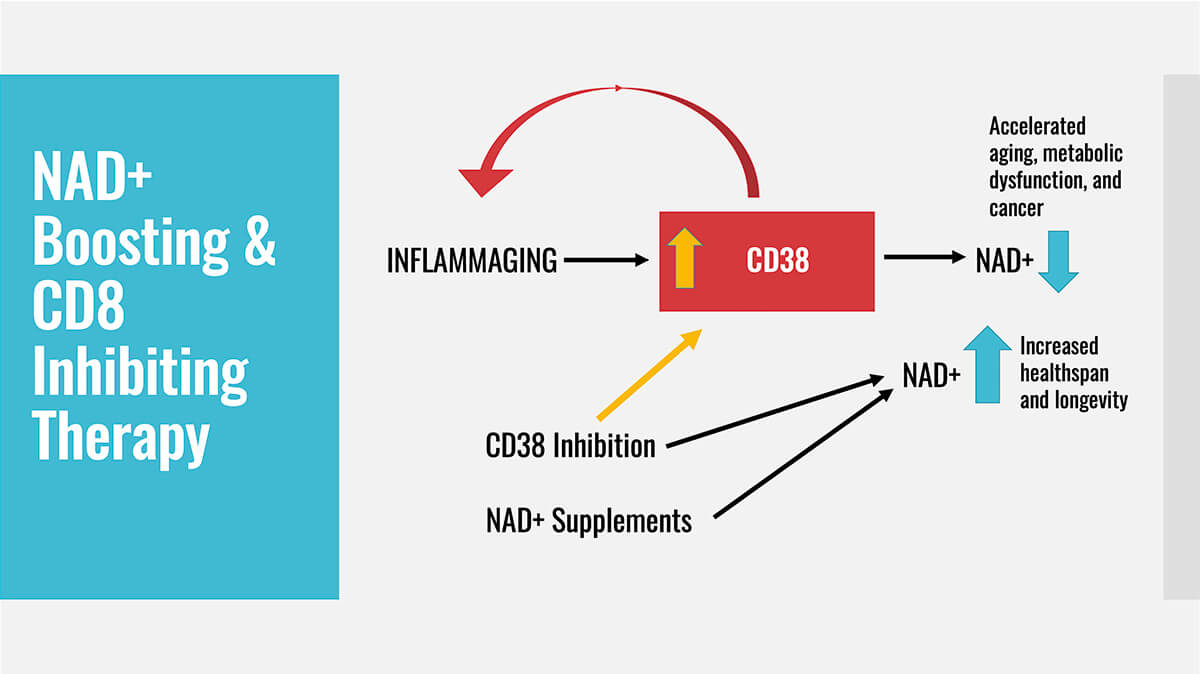
A 2018 paper [7] describes how CD38 manages NAD+ activity during aging. It concludes that shutting down overproduction of CD38 may increase healthspan and longevity, and inhibit some types of cancer.
Boosting NAD+ with supplements increases the pool of available NAD+ without increasing CD38. But that’s theoretical. We don’t know. That’s one reason I recommend low-dose NR or NMN supplements in case too much might drive CD38 higher. The goal is to increase NAD+ and prevent CD38 from getting too high.
Two Ways To Optimize NAD+
It helps to get enough niacin and tryptophan in your diet and to take NR or NMN to enhance NAD+ production. But to optimize NAD+ levels, you must also inhibit CD38 activity.
Our body makes and recycles more than enough NAD+ when we’re young. But, as we get older, two processes occur: (1) NAD+ declines, and (2) CD38 builds up, breaking down more NAD+ and recycling less.
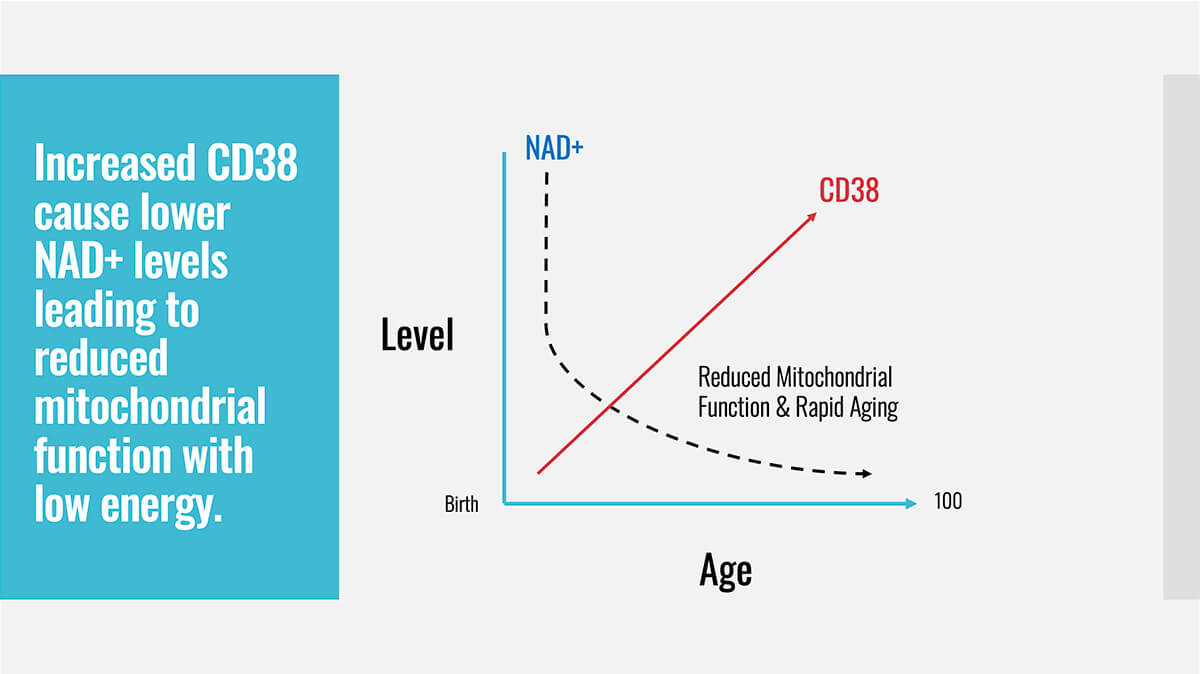
More CS38 means lower NAD+. Over time, it gets worse. Not only does the combination of too much CD38 and low NAD+ increase the chronic inflammation associated with unhealthy aging, but sets us up for heart disease, chronic lung diseases, diabetes, autoimmune disorders, and increases the risk of skin cancer. Low NAD+ may even contribute to weight gain and metabolic syndrome.
Researchers believe that CD38 is the driver of NAD+ decline during aging.
And, it interferes with mitochondrial function. Weakened mitochondria cannot produce sufficient energy to sustain life. The malaise and low energy experienced by CFS (chronic fatigue syndrome) patients is like the reduced energy and impaired exercise tolerance experienced during aging, both due to mitochondrial insufficiency and accelerated by chronic inflammation. [8]
It makes sense that lowering inflammation while increasing NAD+ and inhibiting CD38 is the way to promote healthspan and longevity and increase energy during aging. [9]
Natural Compounds To Lower CD38
Senolytics are a new class of drugs that target cell senescence, the source of aging. When old, dysfunctional cells accumulate, they secrete low levels of inflammatory substances. Chronic inflammation disrupts the normal function of healthy cells triggering a biochemical cascade leading to chronic health conditions and accelerated aging.
One such experimental CD38 inhibitor is thiazoloquin(az)olin(on)e (78c), and others are in early research stages. [10] But, until this new class of drugs is proven safe and effective, natural compounds are your best choice to modulate CD38.
5 Natural Anti-CD38 Compounds:
- Taxifolin is the flavonoid antioxidant dihydroquercetin. It inhibits cancer cells, lowers inflammation, and is useful in the treatment of cardiovascular and chronic liver disease.
- Apigenin is also a flavonoid antioxidant. Apigenin crosses the blood-brain barrier to lower inflammation, improve cell function, enhance brain health, and has anticancer effects.
- Luteolin is another flavonoid found in plants and medicinal herbs. It lowers inflammation, has anticancer properties, and regulates estrogen metabolism.
- Callistephin is the anthocyanin, a type of flavonoid that makes foods dark blue, like blueberries and wine grapes. And, pomegranates are good sources of callistephin.
- Kuromanin is an anthocyanin found in mulberry leaves, chrysanthemum, hibiscus, black currants, red raspberries, lychees, and Peruvian purple corn.
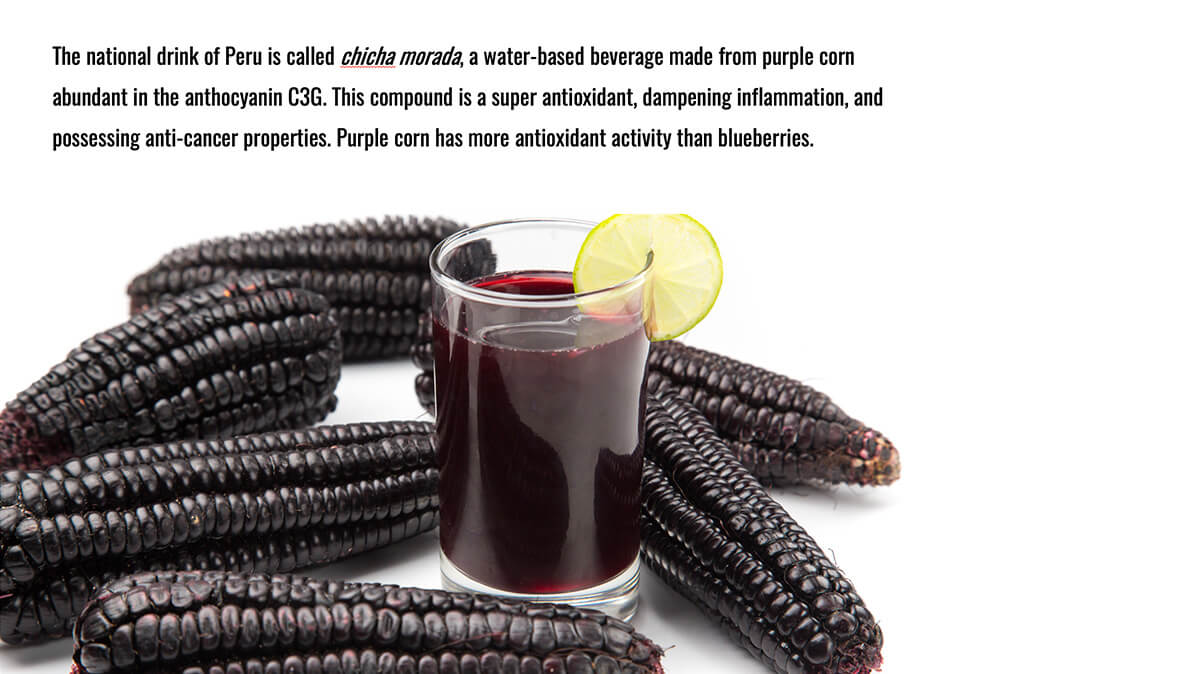
Lifestyle & Diet Prevent CD38 Buildup
Taxifolin, apigenin, and luteolin are available as supplements. However, only a few companies sell them. Kuromanin and callistephin are not yet available as supplements. Your best bet is to include flavonoid and anthocyanin-rich foods and extracts in the diet.
The foundation for a healthy longevity plan is a plant-based, low to moderate carbohydrate diet with a minimal of animal, fish, and seafood. To reverse cardiovascular disease, go vegan. Food choices count. If you eat rice, choose black or wild rice to provide anthocyanins. Eat both raw and cooked foods, including superfood concentrates and fresh juices. Bitter greens like dandelion have more flavonoids. Green tea and herbal teas are rich in polyphenols. And, when choosing vegetables, fruits, and juices pick those high in flavonoids and rich in anthocyanins like red cabbage, red onions, and blood oranges.
Foods High in Anthocyanins:
- Acai
- Black plums
- Black raspberries
- Black rice
- Blood oranges
- Blueberries
- Chokecherry
- Concord grapes
- Currants
- Purple corn
- Red cabbage
- Red raspberries
Evolutionary Benefits of Intermittent Fasting
During times of famine or fasting, our ancestors’ molecules were stimulated, triggered by calorie restriction to increase NAD+ energy production. Fasting providing the edge necessary for survival. Today, people in the West rarely experience famine, or fast, so their NAD+ levels are under stimulated. By the time we reach 50 years our NAD+ is trending lower.
Though a shadow of what our ancestor experienced, those who practice intermittent fasting experience an energy high from NAD+ bursts. But fasting isn’t for everyone. The Fasting Mimicking Diet (FMD) developed by Valter Longo provides the health benefits of a 5-day fast while enjoying food. Studies found the FMD decreases gastrointestinal disease, reverses diabetes, and lowers systemic inflammation. [11]
Ketogenic Diet
Another way to boost NAD+ is by eating a high-fat, low-carbohydrate ketogenic diet. Researchers found high ketones produce more NAD+ in the brain and reduces inflammation. [12] Ketones are an alternative fuel for the brain and muscles. Glucose is the primary source of energy in the body. But a ketogenic diet isn’t right for everyone.
A ketogenic-mimicking diet or supplementing with MCT oil (capric and caprylic acid triglycerides) may be an alternative way to maintain healthy NAD+ levels without eating a high-fat diet.
Two Paths To Reach The 100-Year Life
NAD+ promotes cellular metabolism and improves cell repair. It benefits the nervous system, reduces pain, stimulates arterial healing, improves cognitive function, and restores muscular conditions, including the prevention of sarcopenia.
For those with chronic disease, cancer, or other adverse conditions associated with aging, getting NAD+ infusions can reverse DNA damage, increase antioxidant intake, modulate inflammation, and slow neurodegenerative changes.
Supplementing with NAD+ boosters is fundamental for healthy aging for all adults over 50 years who want to reach the 100-year life. But, taking NAD+ boosters is not enough. To reach the 100-year life, prevent rising CD38 and support NAD+ levels.
Path one: Raise Your NAD+
- Assure adequate dietary and supplemental sources for niacin, nicotinamide, and tryptophan.
- Take resveratrol 100 mg (trans-resveratrol), pterostilbene 50 mg (methylated resveratrol), and Coenzyme Q10 200 mg (ubiquinone).
- Take Nicotinamide mononucleotide (NR) 125 mg daily or Nicotinamide riboside chloride (NMN) 125 mg once or twice daily.
- For those with concerns about abnormal DNA methylation, take NMN powder 30-50 mg daily.
- For an NAD+ boost, take NADH 5 mg sublingual tablets. To prevent jet lag, take NADH 20 mg.
- To reach optimal NAD+ levels, get intravenous ß-Nicotinamide adenine dinucleotide infusions weekly or monthly.
Path two: Lower Your CD38
- Take Taxifolin (diydroquercetin from Siberian larch tree) 50 mg daily.
- Take Apigenin (derived from grapefruit) 50 mg daily.
- Take Luteolin 50 mg daily.
- Eat anthocyanin-rich superfoods, including purple corn extract, pomegranate juice, purple grapes, blackberries, and red onions.
SUMMARY
NAD+ is a life-extending compound that provides better health during aging. However, there’s more to NAD+ than taking a supplement. A healthy lifestyle, including a plant-based diet rich in flavonoids is necessary for strong NAD+. So is regular, intensive exercise. And when you take NAD+ boosting supplements, add nutraceuticals and foods rich in anthocyanins to regulate CD38. If you want to age well, stay independent, and reach 100 years or more without chronic degenerative disease, balance your NAD+ and keep CD38 under control.
Notes
[1] Dychtwald was among the first to predict the explosive population growth of those over 65, and the business opportunity the boomer century (1946-2046) would create.
[2] National Research Council (US) Panel on a Research Agenda and New Data for an Aging World. Preparing for an Aging World: The Case for Cross-National Research. Washington (DC): National Academies Press (US); 2001. 2, Our Aging World. Available from: https://www.ncbi.nlm.nih.gov/books/NBK98375/
[3] Henchoz, Y., von Gunten, A., Büla, C., Seematter-Bagnoud, L., Nanchen, D., Démonet, J. F., Santos-Eggimann, B. (2019). Do baby boomers feel healthier than earlier cohorts after retirement age? The Lausanne cohort Lc65+ study. BMJ open, 9(2), e025175. doi:10.1136/bmjopen-2018-025175
[4] Chini E. N. (2009). CD38 as a regulator of cellular NAD: a novel potential pharmacological target for metabolic conditions. Current pharmaceutical design, 15(1), 57–63.
[5] Camacho-Pereira, J., Tarragó, M. G., Chini, C., Nin, V., Escande, C., Warner, G. M., … Chini, E. N. (2016). CD38 Dictates Age-Related NAD Decline and Mitochondrial Dysfunction through an SIRT3-Dependent Mechanism. Cell metabolism, 23(6), 1127–1139. doi:10.1016/j.cmet.2016.05.006
[6] In association with NAD+ decline during aging, researchers use the term CD38, or the abbreviations NADase CD38 or CD38/NADase. In this report, to keep it simple, I just use CD38.
[7] Eduardo N. Chini, Claudia C.S. Chini, Jair Machado Espindola Netto, Guilherme C. de Oliveira, Wim van Schooten, The Pharmacology of CD38/NADase: An Emerging Target in Cancer and Diseases of Aging, Trends in Pharmacological Sciences, Volume 39, Issue 4, 2018, Pages 424-436.
[8] Claudia C.S. Chini, Mariana G. Tarragó, Eduardo N. Chini, NAD and the aging process: Role in life, death and everything in between, Molecular and Cellular Endocrinology, Volume 455, 2017, Pages 62-74.
[9] Chini E. N. (2009). CD38 as a regulator of cellular NAD: a novel potential pharmacological target for metabolic conditions. Current pharmaceutical design, 15(1), 57–63.
[10] Inhibition of CD38 with the thiazoloquin(az)olin(on)e 78c protects the heart against post-ischemic injury, James Boslett, Nikhil Reddy, Yasmin A Alzarie and Jay L. Zweier
Journal of Pharmacology and Experimental Therapeutics January 11, 2019.
[11] Cheng, C. W., Villani, V., Buono, R., Wei, M., Kumar, S., Yilmaz, O. H., … Longo, V. D. (2017). Fasting-Mimicking Diet Promotes Ngn3-Driven β-Cell Regeneration to Reverse Diabetes. Cell, 168(5), 775–788.e12. doi:10.1016/j.cell.2017.01.040
[12] Elamin, M., Ruskin, D. N., Masino, S. A., & Sacchetti, P. (2017). Ketone-Based Metabolic Therapy: Is Increased NAD+ a Primary Mechanism?. Frontiers in molecular neuroscience, 10, 377. doi:10.3389/fnmol.2017.00377


